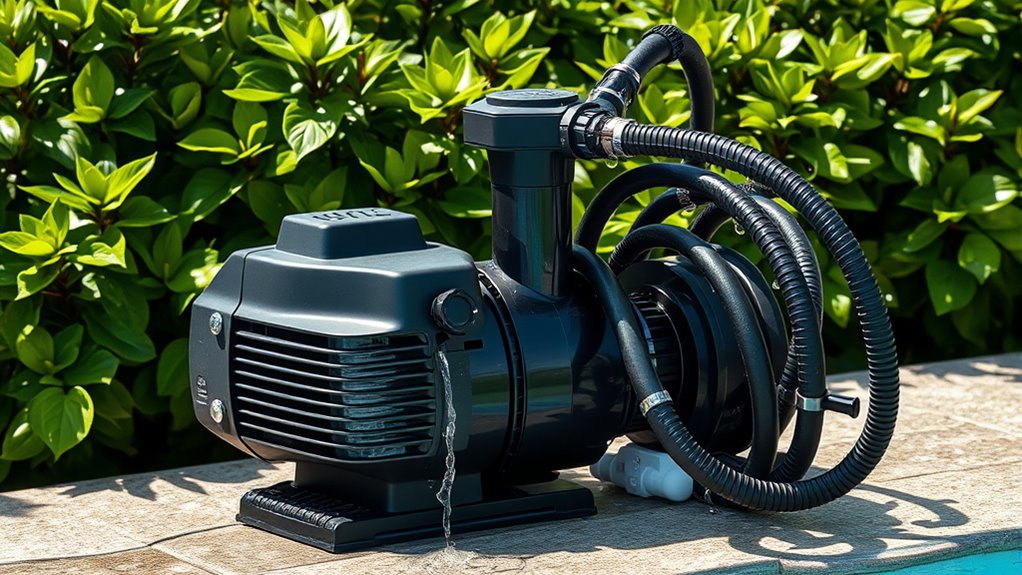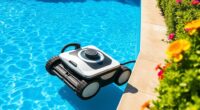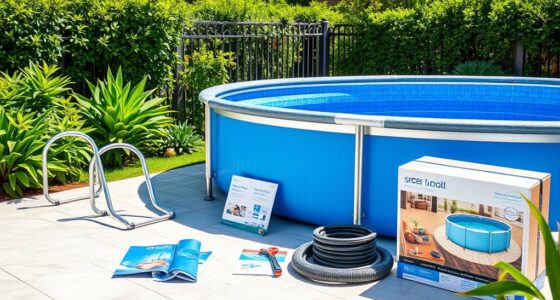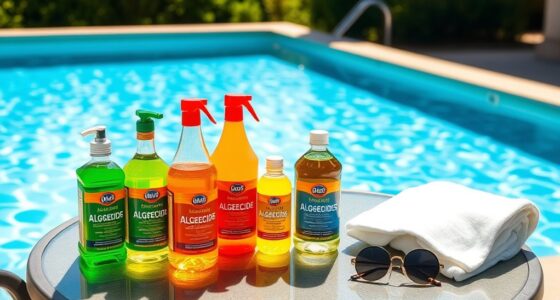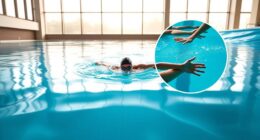Pool pumps are the heart of your water circulation system, keeping your pool clean and balanced. They guarantee water flows through filters and distribute chemicals evenly. You’ll find various types, like single-speed, dual-speed, and variable-speed pumps, each with different energy efficiencies. A variable-speed pump is your best bet for saving on energy costs. Regular maintenance is key to extending the life of your pump. Stick around to discover more about optimizing your pool’s performance.
Key Takeaways
- Pool pumps are essential for circulating water through filters, heaters, and chlorinators, ensuring clean and balanced pool water.
- Single-speed pumps operate constantly, while variable-speed pumps offer efficiency and energy savings with adjustable speeds.
- Compatibility with common pipe sizes and dual voltage capability enhances installation flexibility for various pool setups.
- Regular maintenance, including inspections and cleaning, is crucial for extending the lifespan and effectiveness of pool pumps.
- Investing in energy-efficient pumps reduces operational costs and minimizes environmental impact through lower energy consumption.
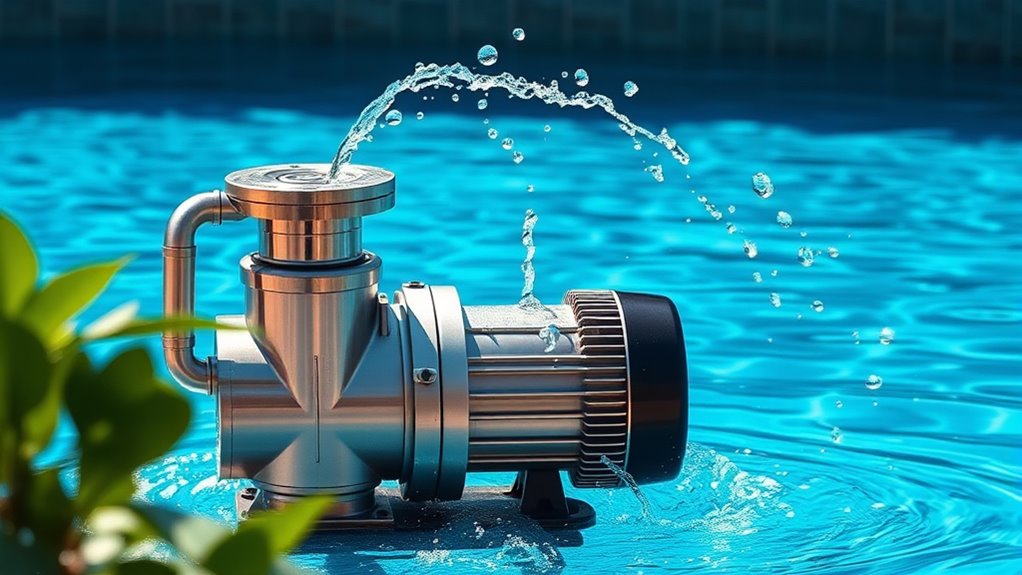
When it comes to maintaining a clean and inviting pool, choosing the right pump is vital. The pump serves as the heart of your pool’s water circulation system, making certain that water flows through filters, heaters, and chlorinators. This process not only keeps the water clear but also helps distribute chemicals evenly and remove debris. However, with various types of pumps available, you need to select one that fits your pool’s specific requirements.
Single-speed pumps operate at a constant speed, which can lead to higher energy costs and reduced efficiency. If you want a bit more flexibility, dual-speed pumps allow you to switch between two speeds, saving energy during low-demand periods. However, if you’re looking for the best in energy efficiency, variable-speed pumps are the way to go. They offer multiple speed options that can adapt to almost any pool or spa system, making them the most efficient choice for long-term savings.
Single-speed pumps can increase energy costs, while variable-speed pumps offer unmatched efficiency and adaptability for long-term savings.
The components of the pump also play a significant role in its performance. Most pumps come with Totally Enclosed Fan Cooled (TEFC) motors, which enhance reliability and efficiency. You’ll find that pumps are compatible with various pipe sizes, typically 1.5″ and 2″, allowing for easy installation. Additionally, many pumps feature dual voltage capability, providing flexibility in electrical connections. The flow rate, measured in gallons per minute (GPM), can vary by model, so it’s important to choose one that meets your pool’s needs.
When considering energy consumption, single-speed pumps are the least efficient, while variable-speed pumps stand out for their significant energy savings. Over time, this translates to lower operational costs and a reduced environmental impact. By investing in an energy-efficient pump, you not only save money but also contribute to sustainable practices.
Maintenance is key to making sure your pump operates effectively. Regular inspection and cleaning are important for the longevity of your pump. Different filter types, such as Diatomaceous Earth (D.E.), Sand, and Cartridge filters, require varying levels of maintenance, but all benefit from periodic backwashing. It’s also wise to conduct system check-ups to catch any potential issues early.
Ultimately, when selecting a pump, consider your pool size and features, budget, and energy efficiency goals. With the right pump, you’ll make certain that your pool remains a clean and inviting oasis for you and your family to enjoy.
Frequently Asked Questions
How Often Should I Replace My Pool Pump?
You should consider replacing your pool pump every 8 to 15 years, depending on its quality and usage.
Single-speed pumps typically last 7 to 10 years, while high-quality models may last longer.
Keep an eye on how often you use your pump and the condition of your water.
Regular maintenance can greatly extend its lifespan, so don’t neglect those tasks to avoid premature replacement and save money in the long run.
What Size Pool Pump Do I Need for My Pool?
Choosing the right pool pump size is like finding the perfect rhythm in a song; it keeps everything flowing smoothly.
To determine the size you need, consider your pool’s volume, desired turnover time, and plumbing layout. Generally, residential pools require pumps between .75 HP and 3 HP.
Don’t forget to factor in any additional features, like waterfalls or jets, as they can impact your pump’s flow rate and overall efficiency.
Can I Run My Pool Pump at Night?
Yes, you can run your pool pump at night!
In fact, it’s a great way to save on energy costs since many areas offer lower rates during off-peak hours.
Nighttime operation also helps distribute chemicals evenly, preventing algae growth and maintaining water quality.
Just be mindful of potential cooling effects on your pool temperature.
Setting a timer can make it easy to automate your pump’s nighttime schedule for maximum efficiency.
What Are the Signs of a Failing Pool Pump?
You might notice a few alarming signs that your pool pump’s failing.
Is there debris building up on the floor? Are you spotting algae or bacteria?
Listen closely. Do you hear unusual humming or screeching noises?
Check for leaks or overheating too. If the pressure’s low or the pump keeps shutting off, it’s time to act.
Ignoring these signs could lead to costly repairs and a dirty pool.
Don’t let it get worse!
How Do I Winterize My Pool Pump?
To winterize your pool pump, start by turning off the power at the breaker.
Clean the area and drain all water from the pump and filters by removing drain plugs.
Disconnect hoses and fittings, then check for any additional equipment needing special care.
Consider adding pool-safe antifreeze to protect your pipes.
Finally, inspect seals and gaskets, leave drain caps off, and document your process for a smooth spring start-up.
Conclusion
In the grand ballet of your pool’s ecosystem, the pump takes center stage, gracefully orchestrating the rhythm of water circulation. It’s the unsung hero, quietly ensuring clarity and liveliness in every splash. By nurturing this essential component, you’re not just maintaining a pool; you’re fostering a serene oasis. So, embrace your pump’s steadfast dedication, and let it continue to be the silent sentinel, keeping your waters inviting and your haven sparkling.
